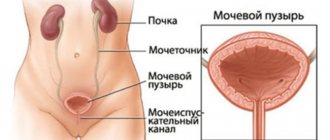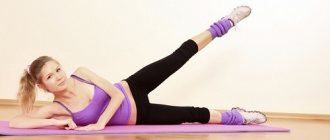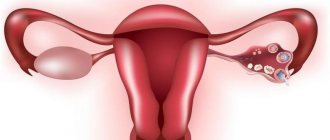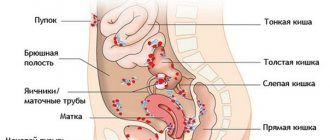Indications for strengthening the perineal muscles
Like any other gymnastic complex, this exercise is mandatory for women leading a sedentary lifestyle , especially those working while sitting. In the absence of contraindications, all representatives of the fair sex should strengthen their pelvic floor muscles. With age, the muscles of the perineum lose tone , the field of birth stretches and cannot properly perform its functions. When is it especially important to start training intimate muscles?
- When planning a pregnancy. By preparing the perineum and vagina in this way for upcoming stress, you can avoid many complications of pregnancy and childbirth.
- During gestation. Gymnastics aimed at strengthening the pelvic floor muscles during pregnancy is an almost 100% guarantee of quick and easy labor.
- After childbirth. The birth of a child is a huge burden on the body in general and the perineal muscles in particular. They stretch, contributing to prolapse of the pelvic organs. Regular training will help tone your intimate muscles in just a couple of months.
- After 30 years, when age-related changes affect all organs and systems of a woman without exception. Strengthening the pelvic floor muscles is a mandatory part of the program to preserve youth and health. In addition, training will help harmonize marital relationships.
- With already diagnosed pelvic organ prolapse, gymnastics for the intimate muscles is therapeutic. By exercising regularly, you can significantly improve the situation and prevent prolapse (loss).
- Enuresis or fecal incontinence also requires treatment with exercise. Very often, it is exercises to strengthen the muscles of the perineum that help solve these delicate problems.
- Congestion in the pelvis triggers inflammatory processes in the internal organs. Gymnastics will help restore blood flow and, accordingly, prevent or cure these pathologies.
Psychosexual disorders such as frigidity, anorgasmia or decreased libido are also reasons to strengthen the pelvic floor muscles. Training will help a woman improve the quality of her intimate life and avoid problems in her relationship with her sexual partner.
Developing intimate muscles
You've probably heard about the famous priestesses of love, geishas, and courtesans. After all, they were born with the same physiological inclinations as we do. And the secret of their popularity among men (more precisely, one of the secrets) is their incredibly developed intimate muscles !
Can't we become just as skilled? Can! Shall we start?
Intimate muscles - what are they? Where is it?
Let's consider the features of the female reproductive system. The external genitalia are represented by the labia majora , which extend upward into the pubis, and below them are the labia minora. The labia minora with their inner surface form the vestibule of the vagina , which once ended with the hymen.
Here, at the entrance to the vagina, the excretory ducts of the glands open, which during sexual intercourse, due to the excitement and tension of the pelvic floor muscles, secrete a secretion (or lubricant) that reduces friction during coitus.
The vagina is a muscular tube ending in the cervix. It has a length of 6-12 cm, depending on age, height, build, sexual activity and whether the woman has given birth or not. It is represented by a mucous layer - internal; muscular - medium; and the outer - connective tissue membrane. The outer lining of the vagina contains a significant amount of elastic fibers, which stretch in all directions during childbirth and during sexual intercourse.
The muscle layer of the vagina resists stretching. It has longitudinal and circular fibers, which ensures the folding of the vagina. The stronger the vaginal muscles, the more distinct the folds. After childbirth, these folds are smoothed out, which is naturally felt by the partner and the owner of the vagina.
Remember: before childbirth..., after childbirth... This happens in a woman who does not develop vaginal muscles.
The orgasmic cuff and the benefits of its development
The strongest muscle is the entrance to the vagina - this is the “orgasmic cuff”. If they are developed and skillfully controlled, the muscles that compress the urethra and anus (sphincters) also develop. Provided you have a strong urethral sphincter, you will avoid the problem of urinary incontinence.
Such troubles often occur in older women or in the last weeks of pregnancy, especially if the expectant mother sneezes or coughs - a urine stain is found on her underwear. If you were bothered by urinary incontinence during pregnancy, you can be sure that in old age, and maybe even earlier, it will definitely make itself felt. But this problem will not affect you - you are developing these important muscles! You can confidently say goodbye to hemorrhoids, which also occur when the anal sphincter is weak and disappears when it strengthens.
About the “harm” of developed intimate muscles
Any developed muscles require sufficient nutrition, the body replenishes this with blood circulation, which is better the stronger the muscles. Those. blood vessels provide the muscles with nutrition. Provided that the vaginal muscles constantly work, the entire reproductive system of a woman is maintained in better condition . This facilitates the process of childbirth - the opening of the vagina during the passage of the fetus, the integrity of the vagina is restored faster and better after childbirth, and postpartum scars become thinner.
Also, due to the natural maintenance of blood circulation in the reproductive system, the ovaries and other appendages of the uterus are saturated. Hormonal metabolism is stimulated, the risk of inflammatory and tumor diseases is reduced . You can count on high-quality, long-term performance of its functions by the entire reproductive system.
As is known, the development of blood vessels occurs in parallel with lymphatic and nervous ones. As for the lymphatic system, it performs an immune function along with the circulatory system, cleanses the vagina of pathogens, maintains the purity of the vaginal flora, protecting the ward organ from bacterial, viral and other troubles. Nerve endings provide sensitivity to the vagina , and, as it were, send a command to the development of blood and lymphatics. In practical life, nerve endings provide sensitivity during sexual intercourse. Those. coordinated tension of intimate muscles causes irritation of nerve endings and a signal of pleasure is delivered to the brain.
In addition, as you understand, developed muscles narrow or expand the volume of the vagina as needed , i.e. depending on the situation.
Such worship of the will of the mistress plays a huge role in intimate life, and the size of manhood ceases to play a significant role.
What happens to intimate muscles during life
It looks something like this: In the vaginal mucosa of newborns and young children, the folds are not pronounced, i.e. the muscles are still weak. Let's remember that children pee and correct themselves. The vaginal muscles develop along with the urinary and anal sphincter. Their formation ends by 7-8 years , subsequently the number of muscular-mucosal folds increases until the onset of puberty.
By the age of 13-15, the vagina noticeably lengthens. Sexual intercourse and repeated childbirth gradually smooth out the folds of the vagina , causing stretching of its wall, and therefore the vagina becomes wider and longer, losing its former elasticity. The muscular wall of the vagina is stretched, which, like any other muscle, in the absence of training becomes flabby and loosens .
Starting from the age of 25-30, in the muscular system of our body, in the absence of training, natural age-related changes begin to appear: tone, strength and mass of muscle tissue are lost . The result of these processes is not slow to affect the quality of our health and life in general. In the absence of muscle work, the aging process is significantly accelerated.
Prolapse of the vaginal walls
What is interesting is that in the process of training the vaginal muscles, the muscles of the thighs, buttocks, and abdomen are tightened , i.e. all the muscles that provide the grace of our body.
In addition to aesthetic value, the abdominal muscles are directly related to the ligamentous, supporting apparatus of the uterus, because some ligaments of the uterus are woven into the abdominal muscles and, when the press is tense, they tense together with them, pulling the uterus and vagina behind them, which is the prevention of prolapse and prolapse of the uterus .
This refers to the suprapubic abdominal muscles, which are included in the work along with the tension of the vaginal muscles. In no case does it mean that if you “pump up” your abs, you can avoid vaginal prolapse. Sports activities must be approached very carefully, because... self-prescribed physical training can only aggravate the sprain of the uterine ligaments.
And the reason for vaginal prolapse and prolapse is very simple . With weak ligaments and muscles of the vagina, every lifting of weights, physical activity, sudden weight loss, or vice versa, leads to a relaxation of the tone of these already fragile muscles. Those. weak ligaments do not hold the uterus on top, and weak vaginal muscles do not support the bottom.
Vaginal prolapse is the scourge of mothers of many children, women engaged in heavy physical labor, those who are obese or suddenly losing weight, and women who avoid sports.
Menopause - where youth ends
Did you know that Eastern women, or in other words, women who know how to control their intimate muscles, have periods until they are very old !
What's good here, you ask? The aging of the female body begins precisely with the cessation of menstruation . Think about the health of your beloved grandmother, you can ask her the question “How did she feel in her youth,” when, just like you now, she ran to dances.
After the cessation of menstruation, a woman’s hormonal levels are rearranged , the functions of the ovaries fade away, which leads to negative consequences: calcium is washed out of the bones - osteochondrosis, osteoporosis, fractures, clumsy gait; the activity of the nervous system is disrupted - tearfulness, forgetfulness, sleep disturbance. The cardiovascular system breaks down - hot flashes, hypertension, angina pectoris and many more “pleasant” companions of old age.
And first of all, a woman’s biological age depends on the activity of the “female heart” - the ovaries, which are capable of producing a balanced amount of hormones, provided there is sufficient blood flow to them. And you already know that good blood circulation is where the muscles work . Because They are the ones who stimulate the bloodstream to work. Especially at a “critical” age, your body needs your help and, believe me, it is completely indifferent to your employment or any other problems.
When choosing youth, remember where its heart is!
Some exercises for developing intimate muscles
"Kegels"
Exercise for coordinated control of the muscles of the orgasmic cuff. During urination, stop abruptly and then continue urinating, do the exercise until you understand which muscles you are working. After 1-2 urination processes you will understand this.
Please do not overuse these exercises as... can cause inflammatory diseases of the bladder. After mastering the Kegel exercise, immediately begin Blinking.
"Blinking"
We blink the same muscles with which you stopped urinating throughout the day, i.e. compresses and unclenches them 500 times a day. Those. “blinking” until there is slight sexual arousal.
The sphincter of the urethra and anus are strengthened (prevention of hemorrhoids, urinary incontinence) and, naturally, we prevent inflammatory diseases and vaginal prolapse, strengthen the muscles of the entrance to the vagina (but only the entrance, deeper vaginal muscles are not involved in this).
"Ball"
We first buy balls with a loop (in a sex shop). You stock up on a hook, which you hook at one end to a loop of balls, as well as a plastic bottle up to 2 liters in volume. Insert the balls into the vagina, attach the hook to the loop that looks out of the vagina. There is also a thread tied to the neck of the water bottle; you use it to cling to the hook. Holding your entrance muscles, you try to lift the water bottle off the floor and walk. The more water you carry in the bottle, the better. It is better to start wearing with 0.5 l. water for 1-2 minutes a day.
"Geisha"
Try to repeat the experience of the geishas: carry a bottle of champagne by the neck for a distance of 100 m. If you succeed, you don’t need to train - you are perfection. Didn't work on the first try? Rest assured, you will be able to do this after some effort.
Please do not try the exercise if you have never trained your intimate muscles, or if you have been diagnosed with vaginal prolapse, etc. during pregnancy.
Contraindications for independent training of intimate muscles
- Pregnancy.
- Acute inflammatory diseases.
- Diseases of the reproductive system requiring immediate surgical treatment.
The use of intimate muscles in sex
And now a few words about managing or applying a developed input to life: if you want to further stimulate your partner, do the “virgin” exercise . When your partner is just trying to penetrate you, squeeze the entrance to the vagina as hard as you can (orgasmic cuff). Use this trick only if your partner is capable of long-term intercourse, because... if a man reaches orgasm too quickly, it won’t last long, and then you may not have time to get pleasure.
During intercourse, it makes no sense to compress the entrance, because... the tight compression when sliding along the shaft of the phallus causes not so pleasant sensations in men, and sometimes even irritation. Although, if you want to “slow down” a man, you can very well use this skill.
When you learn to expand the vagina, push the cervix towards your partner, squeeze the muscle rings of the vagina in a wave-like manner, completely clamp the phallus, and suck on the cervix, then the “Virginity” exercise will be only the initial stage of intercourse. You should not forget about a strong entrance, because... With the help of an orgasmic cuff, a tight “entry” is performed, after which it is advisable to apply a “tight embrace”, but this is more complicated.
Source - https://www.irenclub.org/
Contraindications
Training the muscles of the perineum, as can be seen from the previous section, is necessary for all women at any age . However, under certain conditions of the body, physical activity for the pelvic floor muscles is contraindicated :
- Inflammatory diseases of the pelvic organs in the acute stage. Cystitis, endometriosis, adnexitis and other pathologies require preliminary drug treatment.
- Neoplasms of various types. If malignant or benign tumors are diagnosed, it is strictly forbidden to do gymnastics for the muscles of the perineum.
- Recent surgery , as well as a tendency to uterine and hemorrhoidal bleeding.
- Any infection accompanied by a rise in temperature and general intoxication of the body.
- Venous insufficiency.
- Cervical erosion.
During pregnancy, stress on the pelvic floor muscles should be avoided if there is increased uterine tone, gestosis, or previous miscarriages.
Advanced level
Professionals train the muscles of the perineum with the help of special accessories. Kegel balls are especially popular among women. This gymnastics complex is performed in stages.
- First you need to feel the pelvic floor muscles. To do this, insert a finger into the vagina no deeper than two centimeters. The walls tense up as if urination stops.
- The balls are lubricated with a water-based gel, inserted into the vagina, and the thread remains outside.
- Beginners perform the exercise in a horizontal position. Women with experience handle balls while standing. The tension is proportional to the rest period. Ideally, you should hold the balls for 10 seconds, but in the early stages it may be 2-4 seconds.
It is best to exercise with a Kegel machine three times a week. The diameter of the balls varies. The smaller they are, the more difficult it is to contract the muscle. Such exercises are not contraindicated for pregnant women.
0
It is very important to take care of your women's health and know how to train the vaginal muscles. Kegel exercises will help with this. When you work out in a fitness room on machines or with sports equipment, sooner or later these exercises give a visible effect. Either muscle mass increases, or the body becomes more prominent and toned. In turn, intimate muscles are not visible from the outside, but the degree of their development affects many areas of life, especially the quality of intimate life.
Description and set of exercises for the pelvic floor muscles
To train the muscles of the perineum, a popular complex called Kegel exercises . This American scientist described and proved the importance of such training back in the middle of the last century. You can practice anywhere, since it is completely invisible from the outside, the main thing is to master the basic techniques.
There are actually three of them:
- compression - tension of the intimate muscles for a certain time;
- contraction – rapid alternation of tension and relaxation;
- pushing out - actions similar to labor attempts.
It is very important during the exercise to tense the muscles of the pelvic floor, and not the gluteal muscles and abdomen. To accurately determine the target muscle group, you need to hold the stream while urinating, sitting on the toilet with your legs apart. At the same time , neither the hips nor the buttocks should tense.
Frequent training is the key to rapid progress . Doctors recommend performing the proposed complex at least 5 times a day , especially since this can be done anywhere and at any time. Body position also does not matter (standing in transport, sitting at work, lying in bed):
- Alternate compressions with relaxations. In this case, the duration of muscle contractions should be equal to the pause between them (for beginners - from 3 seconds, and as the muscles strengthen - 1-1.5 minutes). Do about 15 repetitions.
- Contractions are performed at a fast pace for 5 seconds , then a pause of equal duration is made. Do at least 3 repetitions.
- One of the most effective exercises is the “elevator”. At first, the muscles of the perineum tense weakly, then a little stronger, and finally, to the maximum. Relaxation occurs in the reverse order, which allows you to work the deepest muscles. In this case, at each stage you need to linger for 5-10 seconds.
- “Wave” means alternating contractions of the muscles of the anus and perineum (with fixation of tension in each zone for 5-20 seconds). Beginners are recommended to repeat the element at least 5 times per workout, and as the muscles strengthen - 10 or more.
- Push-outs are done 5 to 10 times with a delay in a tense state for 5-10 seconds. Women who have given birth are familiar with the pushing technique, but childless women need to strain the pelvic floor muscles as when defecating.
to train daily, from 5 times a day . The minimum number of repetitions for beginners is 5, and by the end of the first month of training - at least 20. You also need to fix the muscles in a tense state for as long as possible, starting from 5-10 seconds and increasing to 1.5 minutes as they strengthen.
Preparatory stage
The pelvic floor muscles are in a different state for each woman. It is difficult to determine which exercises to start with. To correctly determine the level of neglect, it is worth conducting a simple test.
You need to sit on the very edge of the chair. The legs are slightly spread, and two fingers are inserted into the vagina - the middle and index. They should be spread apart, in the form of a checkmark or the English letter V. After this, you should try to make a contractile movement; the fingers will involuntarily connect. At the same time, the gluteal muscles and abs should not contract. In this way, the tone of the perineum can be assessed. After the training set has been completed, this test must be repeated. The result will be obvious.
It's best to practice when no one is home. Even your spouse doesn’t have to watch this picture. Otherwise, the training regime will be disrupted. All exercises to strengthen the vaginal muscles are performed in a horizontal position. The floor is ideal for these purposes. If your back is uncomfortable, you can put a rug or blanket on it.
The very first classes are carried out until you feel tired, as a rule, this is no more than 25 minutes. Once the body gets used to the regime, about 45 minutes are allocated for training. The same rules apply to pregnant women. Those who cannot restrain the process of urination should especially think about gymnastics of the intimate muscles.
Additional recommendations
Usually the first results of regular exercise are noticeable within a month. To speed up the process, you need to follow several important rules:
- Monitor your breathing during the workout. It should be deep and uniform, and delays (especially for pregnant women) are unacceptable.
- Having determined the target muscle group, monitor your own sensations. You cannot use your abs, buttocks and thighs to perform exercises.
- Don’t be lazy and perform the complex several times daily. However, excessive loads are also harmful (the total number of repetitions of each element per day is no more than 200).
- If a set of exercises has been mastered perfectly and is performed without difficulty with maximum load, it is worth purchasing special modern simulators.
It is also advisable to consult a gynecologist before starting classes. This will help avoid complications if there are certain contraindications.
Set of exercises (video)
After a month or two of regular training, all women note clear improvements in the intimate area . Libido increases, the quality and quantity of orgasms increases and, accordingly, relationships with a partner become harmonious. In addition, a set of Kegel exercises to strengthen the pelvic floor muscles in women is a reliable prevention of pelvic organ prolapse and other genitourinary diseases.
Indications:
- First of all, those who have weak vaginal muscles should perform a set of exercises.
- Secondly, these exercises are needed to prevent ruptures in the upcoming birth.
- Another indication for exercise is urinary incontinence, which occurs on its own or when coughing and sneezing.
- Uterine prolapse or prevention is also an indication for exercise.
- Dissatisfaction with your sex life also encourages you to start doing Kegel exercises.
- Correct and systematic implementation of Kegel exercises will also help you get rid of hemorrhoids.
- If you regularly perform exercises, the aging process of a woman’s body slows down, and the onset of menopause is also delayed.
- By systematically performing Kegel exercises, blood supply to the pelvic organs improves. In this case, all organs function more efficiently.
- In addition, if Kegel exercises are performed, this will promote faster recovery after childbirth.
Exercises for the gluteal muscles
Katie Bowman, who studies the structure of the pelvic floor muscles and the biomechanics of childbirth, has put forward a theory about the need to develop the muscles of the lower back and buttocks instead of training the pelvic floor muscles. Kegel exercises are bad for men and women with hypertensive or tight pelvic floors and may even make the problem worse. However, they are ideal for those who have weak and strained muscles. Therefore, you should not resort to self-medication without consulting a specialist and before finding out what condition the muscles are in.
Exercises for the abs, buttocks, and hamstrings or inner thighs help stabilize the pelvis and support the abdominal organs, uterus, and bladder. By moving the hip joints and stretching the muscles and ligaments, the sensitivity of the target muscles will increase and the ability to control tension will improve.
The following exercises will improve blood flow and activate recovery and metabolic processes (performed after a 10-minute warm-up):
- Cat . Get on all fours and as you exhale, round your back. Twist your tailbone, tensing your deep abdominal muscles and lowering your head down.
- Gluteal bridge . Lying on your back, bend your knees and place your feet on the floor hip-width apart. Place your arms along your body and, as you exhale, lift your pelvis up, resting on your shoulder blades and feet.
- Birch . Lie on your back, group yourself and lift your straight legs and pelvis up. The shoulders, back of the head and neck should be on the floor. You can place your hands on the floor parallel to your body or rest your palms on your lower back. You can remain in this position from 30 seconds to 8 minutes.
- Deep squats . Place your feet shoulder-width apart (or slightly wider) and begin squatting, moving your pelvis back. Fully stretch your thigh muscles, squeezing your buttocks at the bottom. Squat as low as possible without leaning forward or pushing your knees past your toes.
- Caterpillar . Place your hands on the floor and place your legs straight on a fitball (fitness ball). As you exhale, pull your knees towards your stomach, lifting your pelvis up. Return to the starting position while inhaling.
It is useful to do not only physical therapy, but also muscle stretching, especially Pilates. All yoga complexes also contain exercises that help restore weakened pelvic floor muscles. Videos for beginners will help you master yoga theory and practice. Lessons for practicing at home do not contain complex asanas and are more like stretching classes.
Reluctance to pay attention to the pelvic floor muscles most often leads to problems during childbirth, and after childbirth - to urinary incontinence, wide vagina syndrome, decreased libido and sexual pleasure. Some symptoms go away over time, while others progress. But similar symptoms appear in 75% of women with age, so everyone, without exception, needs to train the pelvic floor muscles. Listen to your body's signals and don't wait for signs of a weakened pelvic floor - do preventative exercises regularly and correctly. Timely therapy will help avoid drug treatment and surgical intervention.
conclusions
Even if you have been involved in sports for a long time and are sure that everything is in order, you should make sure that there really are no problems. This can be done by contacting specialists :
- Urogynecologist
- Gynecologist/Obstetrician-gynecologist
- Women's Physiotherapist/Physiotherapist
- Applied Functional Science Specialist (a physician, physical therapist, or personal fitness trainer who has specialized, certified training and knowledge of the functional and muscular relationships in the body)
Prolapse of internal organs and other problems with the pelvic floor do not occur instantly; the likelihood and speed of their manifestations depends on a combination of many factors: the genetic strength of the connective tissue, the number of pregnancies, births and injuries in them, the load that falls on the body, etc.
Unfortunately, few people know about this, think about it or are involved in prevention. We really want you to take care of your health and always adequately assess the risks associated with this or that type of physical activity. It is important that you know what to do, and then problems will not affect you.
Training the pelvic floor muscles is a proven effective method of preventing its incompetence and its consequences - urinary incontinence and organ prolapse. Arnold Kegel exercises, like other similar techniques, can and should be performed before, during and after pregnancy, as well as as a preventive measure when playing sports or fitness.
References: 1. REVIEW: “Functional anatomy of pelvic floor”, Salvatore Rocca Rossetti, Professor of Urology, University of Torino, Torino, Italy. 2. Principles of core stability in the training and in the rehabilitation: review of literature Larissa Neves Pavin1, Claus Gonçalves2 1 Physiotherapist, São José do Rio Preto-SP, Brazil; 2 Physiotherapy School, University Paulista, São José do Rio Preto-SP, Brazil. Received October 14, 2009 Accepted December 7, 2009 3. Johnson, Joshua, “Functional Rehabilitation of Low Back Pain With Core Stabilization Exercises: Suggestions for Exercises and Progressions in Athletes" (2012). All Graduate Plan B and other Reports. Paper 170. Pool-Goudzwaard A, Slieker ten Hove M, Stoeckart R, et al. Relations between pregnancy-related low back pain, pelvic floor activity and pelvic floor dysfunction. International Urogynecology Journal And Pelvic Floor Dysfunction. November 2005;16(6):468-474. 4. Arab A, Behbahani R, Lorestani L, Azari A. Assessment of pelvic floor muscle function in women with and without low back pain using transabdominal ultrasound. Manual Therapy. June 2010;15(3):235-239 5. Christie C, Colosi R. Paving the way for a healthy pelvic floor. IDEA Fitness Journal. May 2009;6(5):42-49. 6. Thomas W. Myers. Anatomical trains. Myofascial meridians for manual and sports medicine, Publishing house: Meridian-S, 2010 7. Nicole Radziszewski, “Help for Pelvic-Floor Dysfunction” 8. Running, Sue Croft, Physiotherapist with a special interest in pelvic floor dysfunction including urinary incontinence, prolapse conditions, bowel management and pelvic pain for women, men and children. 9. Pelvic floor muscle function in women with pelvic floor dysfunction: a retrospective chart review, 1992-2008. Department of Physiotherapy and Occupational Therapy, Copenhagen University Hospital Glostrup, Glostrup, Denmark 10. Bø K. Urinary incontinence, pelvic floor dysfunction, exercise and sport. The Norwegian University of Sport and Physical Education, Oslo. 11. DeLancey JO, “What's new in the functional anatomy of pelvic organ prolapse?” Norman F. Miller Professor of Gynecology, Professor of Urology, Director Pelvic Floor Research Group, Director Female Pelvic Medicine/Reconstructive Surgery, Ann Arbor, Michigan, USA 12. Pomian A1, Lisik W2, Kosieradzki M3, Barcz E1. "Obesity and Pelvic Floor Disorders: A Review of the Literature." 1st Department of Obstetrics and Gynecology, Medical University of Warsaw, Warsaw, Poland. Department of General Surgery and Transplantology, Medical University of Warsaw, Warsaw, Poland. Department of General Surgery and Transplantology, Medical University of Warsaw, Warsaw, China (mainland). 13. Rocca Rossetti S. “Functional anatomy of the pelvic floor.” Professor of Urology, University of Torino, Torino. 14. Bø K “Urinary Incontinence, Pelvic Floor Dysfunction, Exercise and Sport” 15. Christina Christie, PT. "The Inner Pelvic Core" 16. Christina Christie, PT. “Moves to Strengthen the Pelvic Floor” 17. Christina Christie, PT and Rich Colosi, DPT. "Paving the Way for a Healthy Pelvic Floor"
Vaginal muscles
This organ, related to the external genitalia, is a connection with the internal genital organs located in the pelvis. It is a muscular tube that performs several functions at once.
Its structure is quite simple; from the vulva it passes into the cervix - the final section of the external genitalia.
Its structure also has several shells:
- The muscular membrane is functionally quite important, since sexual status and the birth of a child will depend on its condition.
- The mucous membrane plays one of the main roles; it contains bacteria that form the microflora of most of the genital organs.
The vagina is the most important element in the implementation of sexual function; the condition of the muscular system plays an important role. In addition, the function of childbirth is ensured; the vagina ensures the advancement of the fetus to the outside world.
These are smooth muscle fibers that are necessary to maintain the tone of one of the pelvic organs - the vagina. They cannot be consciously controlled, so very often women complain about the problem of their tone, etc.
The only way to train these muscles is to change intra-abdominal pressure. This requires an alternating increase and decrease in intra-abdominal pressure in order for secondary recruitment of smooth muscle fibers to occur.
Any muscle tissue of the human body requires regular maintenance of tone. In order to achieve this, regular exercises aimed at training muscle fibers are required.
At this time, several rules regarding special exercises must be observed. Such sets of exercises are also called Kegel exercises or vumbiling.
Gymnastics to train and ensure normal muscle function
The main problem with the lack of sports in a woman’s life is lack of time. Working in an office or enterprise, children's clubs, school, taking care of home and family takes up a lot of time, and it is very difficult to find time to visit a club or coach. Fortunately for all the girls in the world, there are Kegel exercises that you can do at home at any time, in any environment.
Performing a series of simple exercises will not take more than 15 minutes. The result, as after any workout, will not be immediate; the first visible effect will be noticeable after a couple of weeks. With daily moderate exercise, there will be a noticeable improvement every day, and after the birth of the child, the girl will not encounter the above problems.










